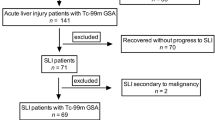Abstract
Protection of hepatocytes from ischemia-reperfusion injury is a clinically important issue. The purpose of this study was to evaluate changes in acute liver damage and recovery after ischemiareperfusion in rats with asialoglycoprotein receptor (ASGP-R) ligand. Ischemia was induced by clamping the hepatoduodenal ligament for 90 min. At 1, 3,24, 48 hr, 1 and 2 wk after reperfusion, I-125-GSA was injected. Five min after injection, blood samples were obtained and the liver was removed. Several regions from each lobe were dissected, weighed and counted. Mean uptakes (% dose/g) in the liver and blood samples were calculated. Histologic sections stained with hematoxylin-eosin (H-E) stain showed ischemic damage at 1 and 3 hr, and focal hepatocyte necrosis at 24 hr. Predominant massive necrosis was not seen. The mitotic index with H-E stain and proliferating cell nuclear antigen (PCNA) labeling index were highest at 1 wk, indicating liver regeneration. At 1 and 3 hr, liver uptake was significantly decreased, and blood uptake was significantly increased, indicating decreased tissue blood flow and ischemic damage. Liver uptake showed significant increases at 48 hr and 1 wk, and was the highest at 1 wk, indicating liver regeneration during the convalescence stage. ASGP-R binding may provide valuable information on ischemia-reperfusion injury and recovery.
Similar content being viewed by others
References
Spiess M. The asialoglycoprotein receptor: A model for endocytic transport receptors.Biochemistry 29: 10009–10018, 1990.
Sawamura T, Kawasato S, Shiozaki Y, Sameshima Y, Nakada H, Tashiro Y. Decrease of a hepatic binding protein specific for asialoglycoproteins with accumulation of serum asialoglycoproteins in galactosamine treated rats.Gastroenterology 81: 527–533, 1981.
Ha-Kawa SK, Tanaka Y. A quantitative model of Technetium-99m-DTPA-galactosyl-HSA for the assessment of hepatic blood flow and hepatic binding receptor.J Nucl Med 32: 2233–2240, 1991.
Kudo M, Todo A, Ikekubo K, Yamamoto K, Vera DR, Stadalnik RC. Quantitative assessment of hapatocellular function throughin vivo radiotracer imaging with Tc-99m-galactosyl human serum albumin.Hepatology 17: 814–819, 1993.
Stadalnik RC, Vera DR, Woodle ES, Trudeau WL, Porter BA, Ward RE, et al. Tc-99m-NGA functional hepatic imaging: Preliminary clinical experience.J Nucl Med 26: 1233–1242, 1985.
Shiomi S, Kuroki T, Kuriyama M, Takeda T, Nishiguchi S, Nakajima S, et al. Evaluation of fulminant hepatic failure by scintigraphy with Technetium-99m-GS A.J Nucl Med 38: 79–82, 1997.
Kudo M, Todo A, Ikekubo K, Hino M. Receptor index via hepatic asialoglycoprotein receptor imaging: Correlation with chronic hepatocellular damage.Am J Gastroenterology 87: 865–870, 1992.
Toyama H, Ito K, Komori Y, Sugioka A, Shibata K, Komai S, et al. Evaluation of the residual functional reserve and the early regeneration after the hepatic resection using asialoglycoprotein receptor imaging agent.KAKU IGAKU (Jpn J Nucl Med) 32: 323–329, 1995.
Colletti LM, Kunkel SL, Walz A, Burdick MD, Kunkel RG, Wilke CA, et al. The role of cytokine networks in the local liver injury following hepatic ischemia/reperfusion in rat.Hepatology 23: 506–514, 1996.
Liu W, Schöb O, Pugmire JE, Jackson D, Zucker KA, Fry DE, et al. Glycohydrolases as markers of hepatic ischemiareperfusion injury and recovery.Hepatology 24: 157–162, 1996.
Schlossberg H, Zhang Y, Dudus L, Engelhardt JF. Expression of c-fos and c-jun during hepatocellular remodeling following ischemia/reperfusion in mouse liver.Hepatology 23: 1546–1555, 1996.
Hashimura S, Kohno Y, Gohbara H, Nakagawa T, Shimizu M, Niiya H, et al. Quantitative evaluation of liver function using Tc-99m-GSA in rats with liver injury induced by ischemia-reperfusion.Nippon Acta Radiologica 52: 77–78, 1992.
Gohbara H, Kohno Y, Sakae K, Satoh S, Shimizu M, Takeda Y, et al. Evaluation of usefulness of Tc-99m-GSA liver scintigraphy on hepatic ischemia-reperfusion injury in rats with obstructive jaundice.Radioisotopes 41: 407–410, 1992.
Wakabayashi H, Karasawa Y, Tanaka S, Kokudo Y, Maeba T. The effect of FK506 on warm ischemia and reperfusion injury in the rat liver.Surg Today 24: 994–1002, 1994.
Kawa S, Hazama H, Kojima M, Nishiyama Y, Nakazawa M, Hasegawa T, et al. A new liver function test using the asialoglycoprotein-receptor system on the liver cell membrane: II. Quantitative evaluation of labeled neoglycoprotein clearance.KAKU IGAKU (Jpn J Nucl Med) 23: 907–916, 1986.
Kouda K, Ha-Kawa SK, Tanaka Y. Increased Tc-99m-GSA uptake per hepatocyte in rats with administration of dimethylnitrosamine or hepatocyte growth factor.J Nucl Med 39: 1463–1467, 1998.
Higgins GM, Anderson RM. Experimental pathology of the liver. I. Restoration of the liver of the white rat following partial surgical removal.Arch Path (Chicago) 12: 186–202, 1931.
Gärtner U, Stockert RJ, Morell AG, Wolkoff AW. Modulation of the transport of bilirubin and asialoorosomucoid during liver regeneration.Hepatology 1: 99–106, 1981.
Rossi AM, Romano M, Zaccaro L, Pulci R, Salmona M. DNA synthesis, mitotic index, drug-metabolising systems and cytogenetic analysis in regenerating rat liver. Comparison with bone marrow test after ‘in vivo’ treatment with cyclophosphamide. Mutation Research 182: 75–82, 1987.
Howard DJ, Stockert RJ, Morell AG. Asialoglycoprotein receptors in hepatic regeneration.J Bio Chem 257: 2856–2858, 1982.
Leveille-Webster CR, Rogers J, Arias IM. Use of an asialoglycoprotein receptor-targeted magnetic resonance contrast agent to study changes in receptor biology during liver regeneration and endotoxemia in rats.Hepatology 23: 1631–1641, 1996.
Kohda K, Ha-Kawa SK, Yamamoto R, Murata T, Harima K, Tanaka Y, et al. Change in lobar uptake of Tc-99m-galactosyl serum albumin after transarterial embolization therapy.Nippon Acta Radiologica 54: 1427–1429, 1994.
Noguchi A, Hasegawa Y, Sasaki Y, Imaoka S, Hashizume T, Ibuka K, et al. Changes of liver function measured by Tc-99m-GSA scintigraphy after hepatectomy.KAKU IGAKU (Jpn J Nucl Med) 32: 419–426, 1995.
Author information
Authors and Affiliations
Corresponding author
Rights and permissions
About this article
Cite this article
Toyama, H., Suzuki, K., Naito, A. et al. Evaluation of asialoglycoprotein receptor imaging agent as a marker of hepatic ischemia-reperfusion injury and recovery. Ann Nucl Med 13, 155–160 (1999). https://doi.org/10.1007/BF03164855
Received:
Accepted:
Issue Date:
DOI: https://doi.org/10.1007/BF03164855




